Connect to and manage Looker in Microsoft Purview (Preview)
This article outlines how to register Looker, and how to authenticate and interact with Looker in Microsoft Purview. For more information about Microsoft Purview, read the introductory article.
Important
This feature is currently in preview. The Supplemental Terms of Use for Microsoft Azure Previews include additional legal terms that apply to Azure features that are in beta, in preview, or otherwise not yet released into general availability.
Supported capabilities
| Metadata Extraction | Full Scan | Incremental Scan | Scoped Scan | Classification | Labeling | Access Policy | Lineage | Data Sharing | Live view |
|---|---|---|---|---|---|---|---|---|---|
| Yes | Yes | No | Yes | No | No | No | Yes | No | No |
The supported Looker server version is 7.2.
When scanning Looker source, Microsoft Purview supports:
Extracting technical metadata including:
- Server
- Folders
- Projects
- Models
- Dashboards
- Looks
- Explore diagrams including the joins
- Views including the dimensions, measures, parameters, and filters
- Layouts including the chart layouts, table layouts, text, and fields
Fetching static lineage on assets relationships among views and layouts.
When setting up scan, you can choose to scan an entire Looker server, or scope the scan to a subset of Looker projects matching the given name(s).
Known limitations
When object is deleted from the data source, currently the subsequent scan won't automatically remove the corresponding asset in Microsoft Purview.
Prerequisites
- An Azure account with an active subscription. Create an account for free.
- An active Microsoft Purview account.
- You need Data Source Administrator and Data Reader permissions to register a source and manage it in the Microsoft Purview governance portal. For more information about permissions, see Access control in Microsoft Purview.
Note
If your data store is not publicly accessible (if your data store limits access from on-premises network, private network or specific IPs, etc.), you will need to configure a self hosted integration runtime to connect to it.
- If your data source isn't publicly accessible, set up the latest self-hosted integration runtime.
- Choose the right integration runtime for your scenario:
- To use a self-hosted integration runtime:
- Follow the article to create and configure a self-hosted integration runtime.
- Ensure JDK 11 is installed on the machine where the self-hosted integration runtime is installed. Restart the machine after you newly install the JDK for it to take effect.
- Ensure that Visual C++ Redistributable (version Visual Studio 2012 Update 4 or newer) is installed on the machine where the self-hosted integration runtime is running. If you don't have this update installed, download it now.
- To use a kubernetes supported self-hosted integration runtime:
- To use a self-hosted integration runtime:
- Choose the right integration runtime for your scenario:
Register
This section describes how to register Looker in Microsoft Purview using the Microsoft Purview governance portal.
Authentication for registration
An API3 key is required to connect to the Looker server. The API3 key consists in a public client_id and a private client_secret and follows an OAuth2 authentication pattern.
Steps to register
To register a new Looker server in Microsoft Purview Unified Catalog, follow these steps:
Open the Microsoft Purview governance portal by:
- Browsing directly to https://web.purview.azure.com and selecting your Microsoft Purview account.
- Opening the Azure portal, searching for and selecting the Microsoft Purview account. Selecting the the Microsoft Purview governance portal button.
Select Data Map on the left navigation.
Select Register.
On Register sources, select Looker. Select Continue.
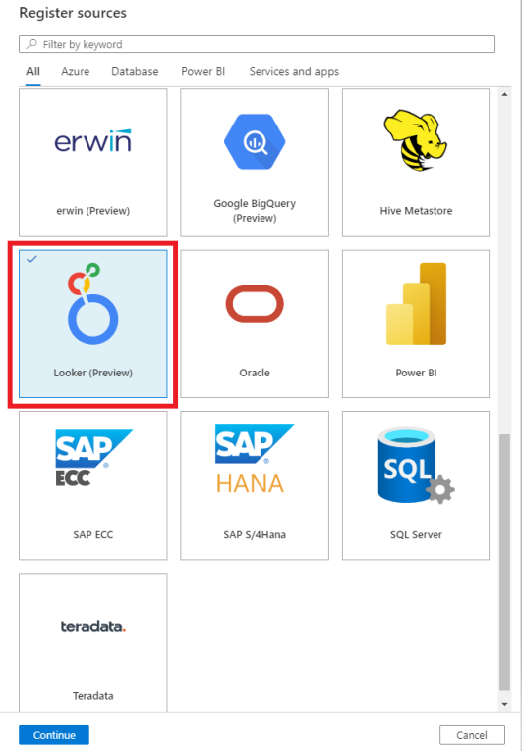
On the Register sources (Looker) screen, follow these steps:
Enter a Name that the data source will be listed within the Catalog.
Enter the Looker API URL in the Server API URL field. The default port for API requests is port 19999. Also, all Looker API endpoints require an HTTPS connection. For example: 'https://azurepurview.cloud.looker.com'
Select a collection from the list.
Finish to register the data source.
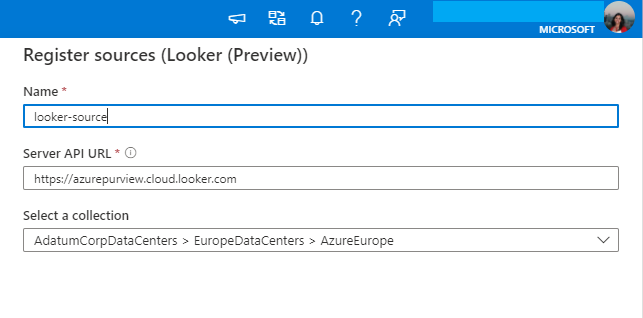
Scan
Follow the steps below to scan Looker to automatically identify assets. For more information about scanning in general, see our introduction to scans and ingestion
Create and run scan
To create and run a new scan, follow these steps:
If your server is publicly accessible, skip to step two. Otherwise, you'll need to make sure your self-hosted integration runtime is configured:
- In the Microsoft Purview governance portal, got to the Management Center, and select Integration runtimes.
- Make sure a self-hosted integration runtime is available. If one isn't set up, use the steps mentioned in prerequisites to set up a self-hosted integration runtime.
In the Microsoft Purview governance portal, navigate to Sources.
Select the registered Looker server.
Select + New scan.
Provide the below details:
Name: The name of the scan
Connect via integration runtime: Select the Azure auto-resolved integration runtime if your server is publicly accessible, or your configured self-hosted integration runtime if it isn't publicly available.
Server API URL is auto populated based on the value entered during registration.
Credential: While configuring Looker credential, make sure to:
- Select Basic Authentication as the Authentication method
- Provide your Looker API3 key's client ID in the User name field
- Save your Looker API3 key's client secret in the key vault's secret.
To access client ID and client secret, navigate to Looker ->Admin -> Users -> Select Edit on a user -> Select EditKeys -> Use the Client ID and Client Secret or create a new one.
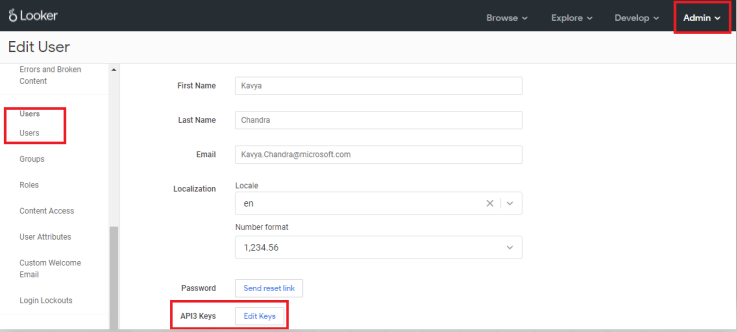
To understand more on credentials, refer to the link here
Model filter - Scope your scan by providing a semicolon separated list of Looker models. This option is used to select looks and dashboards by their parent model.
Maximum memory available (applicable when using self-hosted integration runtime): Maximum memory (in GB) available on customer's VM to be used by scanning processes. This is dependent on the size of erwin Mart to be scanned.
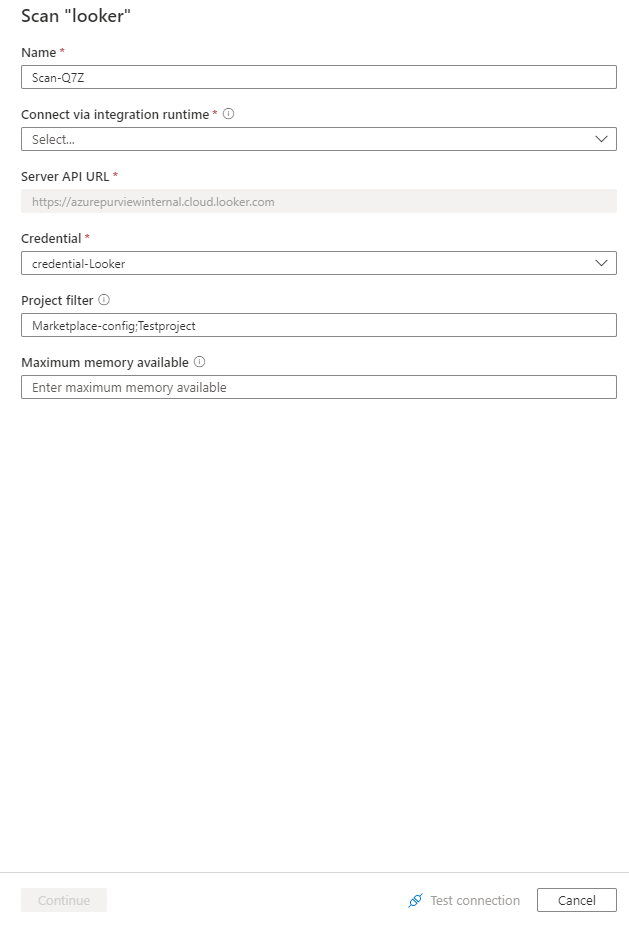
Select Test connection to validate the settings.
Select Continue.
Choose your scan trigger. You can set up a schedule or ran the scan once.
Review your scan and select on Save and Run.
View your scans and scan runs
To view existing scans:
- Go to the Microsoft Purview portal. On the left pane, select Data map.
- Select the data source. You can view a list of existing scans on that data source under Recent scans, or you can view all scans on the Scans tab.
- Select the scan that has results you want to view. The pane shows you all the previous scan runs, along with the status and metrics for each scan run.
- Select the run ID to check the scan run details.
Manage your scans
To edit, cancel, or delete a scan:
Go to the Microsoft Purview portal. On the left pane, select Data Map.
Select the data source. You can view a list of existing scans on that data source under Recent scans, or you can view all scans on the Scans tab.
Select the scan that you want to manage. You can then:
- Edit the scan by selecting Edit scan.
- Cancel an in-progress scan by selecting Cancel scan run.
- Delete your scan by selecting Delete scan.
Note
- Deleting your scan does not delete catalog assets created from previous scans.
Lineage
After scanning your Looker source, you can browse Unified Catalog or search Unified Catalog to view the asset details.
Go to the asset -> lineage tab, you can see the asset relationship when applicable. Refer to the supported capabilities section on the supported Looker lineage scenarios. For more information about lineage in general, see data lineage and lineage user guide.
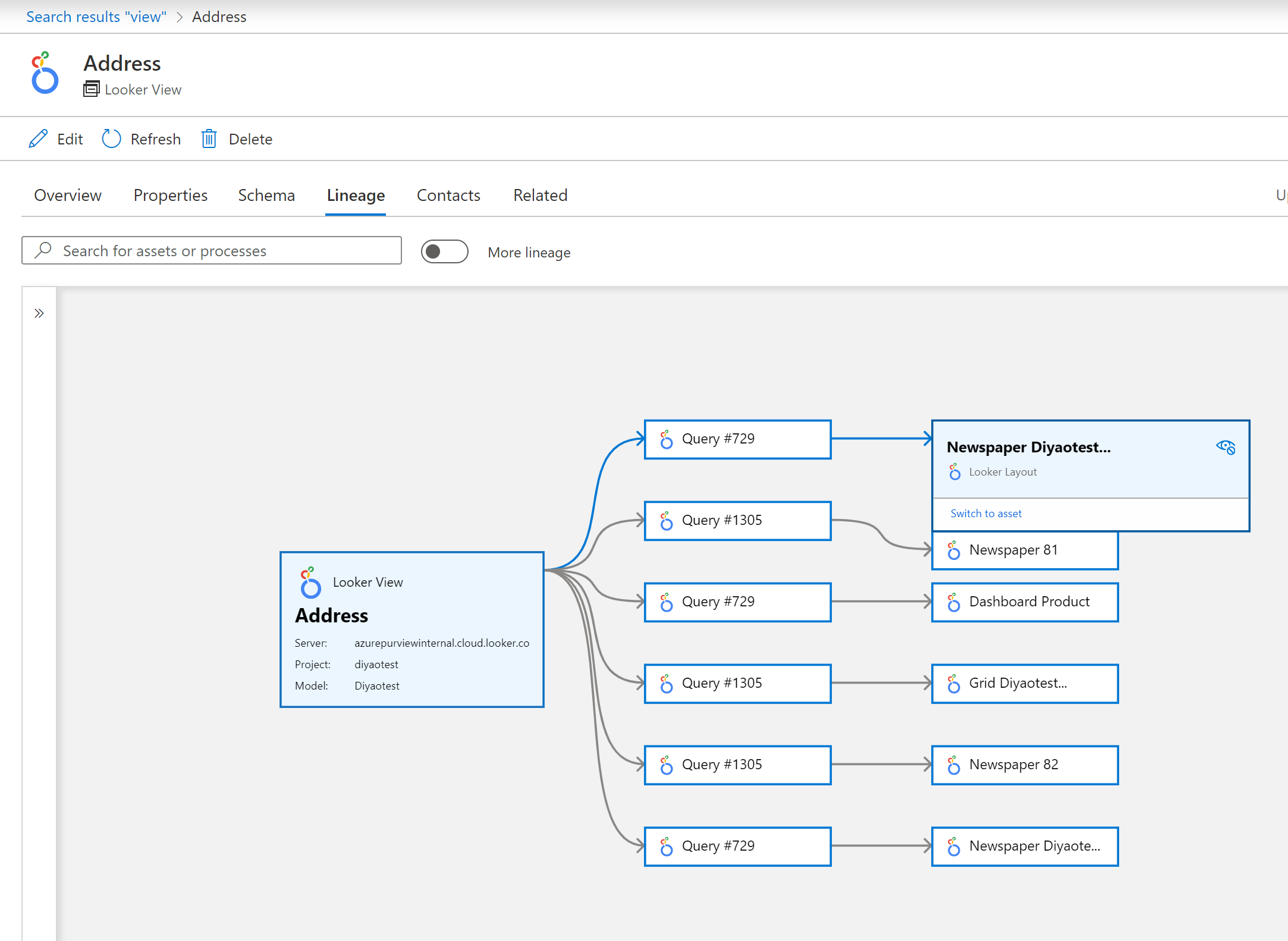
Next steps
Now that you've registered your source, follow the below guides to learn more about Microsoft Purview and your data.